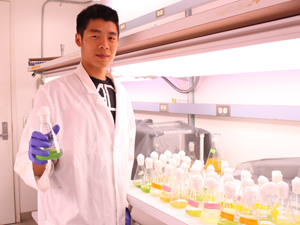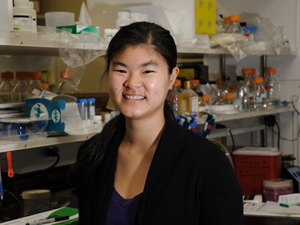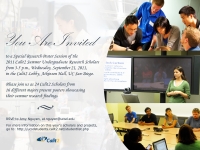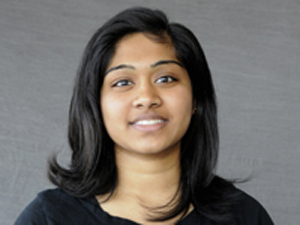Calit2 Undergraduate Summer Scholars Explore Research Interests in Labs Across Campus
By Chris Palmer
|
San Diego, Calif., September 7, 2011 -- Two dozen students from the University of California, San Diego, are taking part in the California Institute for Telecommunications and Information Technology (Calit2) Undergraduate Summer Scholar Program, letting their passion for science and technology guide hands-on research in a multitude of fields.
Under the mentoring of UCSD faculty advisers, the undergraduates engage in full-time research for 10 weeks on an ongoing research project or a new project of their own. In addition, the students attend a series of seminars provided by Calit2 during the summer that cover a variety of topics relevant to academic, industry and research careers.
The scholars receive a $3,000 scholarship to take part in the eleventh annual incarnation of the program, which to date has had approximately 275 undergraduate participants. Research proposals must address the mission of Calit2, which is directed toward research in telecommunications and information technology, as well as advances in a wide range of applications important to the California state economy and quality of life.
The 2011 awardees represent majors in diverse fields from across campus, from biological anthropology to chemistry, physics and communications.
All participants in the Calit2 Undergraduate Summer Scholar Program will display the results of their research efforts at a poster session Wednesday, Sept. 21 at 2:00 p.m. in the Atkinson Hall Pre-Function Area on the first floor. The event is free and open to the public.
|
Ultrasensitive DNA biosensor
In the weeks since the program began, Sinduja Marx, bioengineering and biotechnology major, has been testing a suite of fine-tuned biosensor chips that could significantly decrease the time it takes to detect the several bacterial strains that cause urinary tract infections (UTIs).
UTIs result in seven million office visits and one million hospitalizations per year, and an annual worldwide expenditure of $3.5 billion. “The majority of health costs are due to the two-day waiting period that is necessary for the current class of diagnostic tests to work,” says Marx, who will be a junior this year.
“Usually doctors prefer to start treatment with antibiotics right away. However, because of the relatively long waiting period, they do not know which of the 16 or so specific bacterial pathogens are causing the infection,” she says.
This ultimately leads to the over-prescription of broad-spectrum antibiotics, which could cause adverse drug reactions in individual patients and, over the long term, the emergence of drug-resistant pathogens.
The biosensors that Marx and her academic advisor, Nanoengineering Professor Joseph Wang, work with can reliably detect the DNA of the specific bacterial strain responsible for a patient’s UTI within 45 minutes, assuring that a specific antibiotic can be prescribed within a single office visit.
About the size of a thumb drive, the biosensors contain a series of tiny wells into which biological samples can be deposited. Each well has an electrochemical sensor customized with DNA probes that each target a common strain of urinary bacteria. When the probes recognize the target strain of bacteria, an electric signal is generated that is transformed into a digital readout.
Until recently, the DNA probes have lacked stability, meaning that they had to be inserted into the sensor wells immediately before use. Marx’s experiments have helped identify a set of probes that can remain stable for weeks.
Eventually the goal is to “put the biosensors on the shelf for a month or longer so that technicians would not have to modify them right before the doctor orders a clinical test,” Marx explains, adding that the hope is to make the DNA biosensors as portable and easy to use as the glucose sensors that millions of diabetic patients use on a daily basis.
DNA biosensors similar to the type Marx works with can also be used for food safety, forensic analysis and the detection of cancer and even bioweapons. However, Marx originally became interested in biosensors for their potentially otherworldly applications.
“I was interested in the rovers that NASA sent to Mars and the sensors they used and how they detect life,” says Marx, “but nobody does that at UCSD, so the closest I could get was analyzing life in four micro liters of urine samples.”
Marx hopes to some day work on a project to outfit future generations of space-bound rovers with delicate biosensors that could find proof of life’s existence beyond our planet.
Sending biosensors to Mars, our nearest celestial neighbor, will require extending the shelf life to at least eights months, admits Marx, seemingly undeterred by the challenge.
Natural communication signals of the European Starling

Cory Jameson studies the structural components of birdsong.
Another student that is using the summer scholars program to further his understanding of a subject he is passionate about is Cory Jameson.
Jameson, a jazz and bluegrass musician, is a junior with a double major in cognitive science and physiology and neuroscience. His summer research project has focused on European Starlings’ use of song for natural communications.
“My interest in music led me to neuroscience and how the brain processes sound,” says Jameson.
Working in the lab of Psychology Assistant Professor Timothy Gentner, Jameson has been exploring a novel way to analyze the structure of birdsong. He wrote a custom computer program to separate the various components of birdsong, called motifs, by examining their spectrotemporal modulations, i.e. the way the frequency of the song changes over time.
Jameson notes that there are important parallels between human speech and birdsong, including the stages of learning and the necessity of auditory feedback for learning, as well as anatomical similarities in the brain structures that produce speech in humans and song in birds.
According to Jameson, these parallels “make using a birdsong model for understanding human speech a promising venture.”
Jameson believes that having a logical way to classify the motifs can be useful in differentiating lower order brain areas that process individual song motifs from higher order brain areas that process more complex levels of song perception such as meaning or singer identification.
“It was great to have the whole summer to focus just on my research, without a job or classes getting in the way,” says Jameson, echoing the sentiments of many of his fellow Summer Scholars.
Efficiency of algae biofuel

Tsz Fung (Garfield) Kwan tests combinations of various strains of algae for their potential to produce biofuels.
Tsz Fung (Garfield) Kwan, under the supervision of Ecology, Behavior and Evolution Associate Professor Jonathan Shulin, spent his summer trying to figure out ways to maximize the yield of biofuels that can be extracted from algae.
“One of the main challenges with using algae for biofuels is reducing the losses of algae to pathogens and other predators,” says Kwan, a junior in environmental systems.
He hypothesizes that polycultures (diverse species growing together) may be more efficient at capturing and converting sunlight into biomass than any monoculture (single species growing independently).
“If one species fails, the other species in the population can take over and maintain energy production,” says Kwan. “Also, different algae species absorb different wavelengths of light, so a polyculture can potentially utilize the full spectrum of light for photosynthesis.”
To test his hypothesis, Kwan experimented with growing 10 species of algae in isolation, as well as in various polyculture combinations, for a total of 31 different test samples.
Kwan says there is a tradeoff for the algae between producing lipids, which are the basis of biofuels, and fighting off competing species of algae.
“Some species grow better together and produce lots of lipids, but in some combinations the algae compete against one another, and so lipid production decreases. It comes down to resource partitioning.”
“It’s still too early to tell which combination of algae species will end up being the most efficient.”
Kwan grew the various populations of algae at the Biological Field Station on the northeast corner of the UCSD campus. Over the summer, the algae grew inside in rows and rows of beakers in a controlled, indoor environment, but the plan is to move the most productive combinations of algae outside into vast pools to see how they tolerate natural conditions.
Cardiac differentiation through non-coding RNAs

Kristine Tan searches for genetic factors that can regulate the differentiation of stems cells in cardiac muscle cells.
Soon to be sophomore, Kristine Tan, has been investigating factors that regulate the differentiation of stem cells into cardiac muscle in the lab of Cardiology Assistant Professor, Neil Chi.
“When someone suffers from cardiovascular disease, their damaged cardiac tissue has very limited, if any, ability to regenerate,” says Tan.
“Stem cell therapies can be used to replace the damaged or lost cardiac cells.”
Tan used the UC Santa Cruz Genome Browser to identify a small number of recently discovered genetic elements called ‘long non-coding RNA transcripts’ that may trigger a series of subtle changes in human stem cells that can coerce their development into heart muscle cells.
Tan then searched for those specific cardiovascular-associated RNA transcripts in a variety of human tissue types using ‘polymerase chain reaction’, a procedure that amplifies genetic material thousands of times.
“We found much higher levels of expression of these particular RNA transcripts in heart muscle cells than in other tissue types,” says Tan. Expression levels were high in both fetal heart tissue and adult heart tissue, suggesting a role for the transcripts in heart muscle cell development and maintenance, respectively.
The next step in Tan’s project is to underexpress or overexpress the cardiac RNA transcripts in human tissue and test whether the tissue has the same physical properties of heart muscle, such as the ability to contract.
Tan, along with the other Summer Scholar participants, appreciates the skills she learned in the program. “I really enjoyed the presentations at Calit2 about how to land a job, how to network, and how to write a resume.”
“Also, it has really been a good experience seeing what a full time research position would be like.”
Media Contacts
Chris Palmer, 858-534-4763 or crpalmer@ucsd.edu
Related Links
Calit2 Summer Scholars Program
Calit2 2011 Summer Scholars Preview



